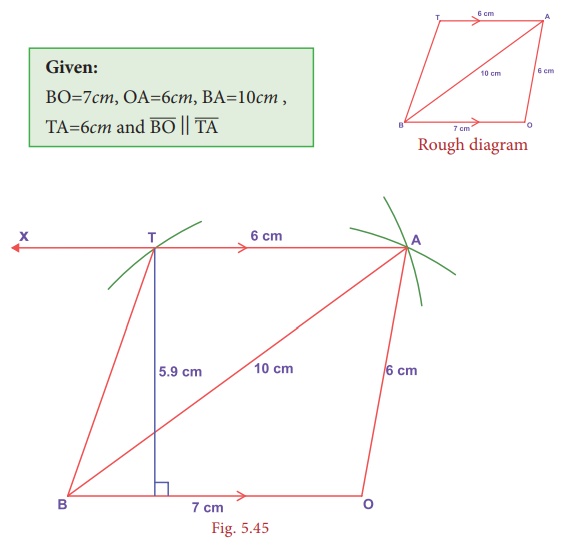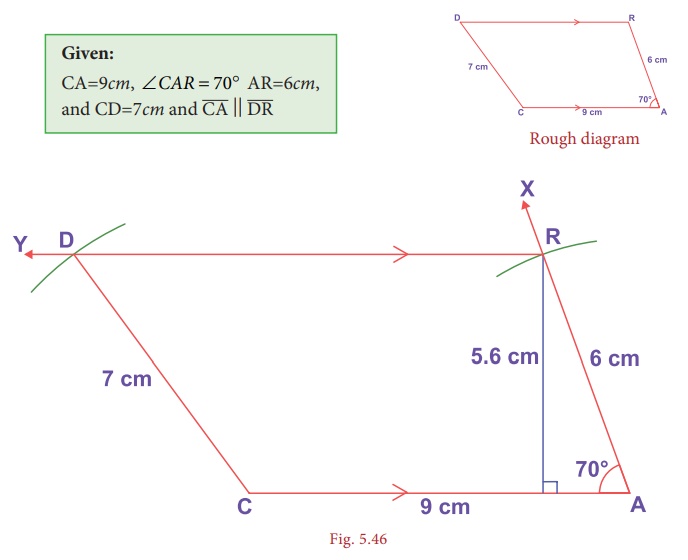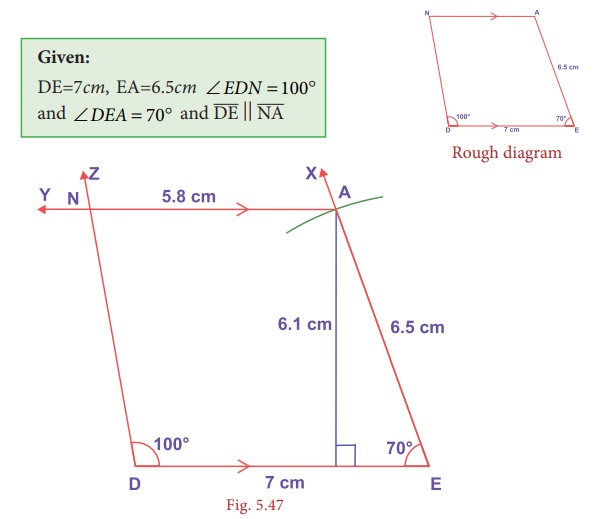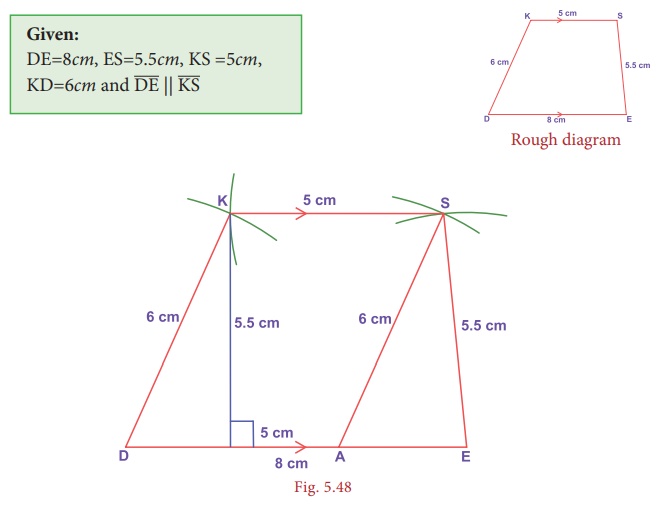Questions with Answers, Solution | Geometry | Chapter 5 | 8th Maths - Construction of Trapeziums | 8th Maths : Chapter 5 : Geometry
Chapter: 8th Maths : Chapter 5 : Geometry
Construction of Trapeziums
Construction
of Trapeziums
In the first
term, we have learnt how to construct the quadrilaterals. To draw a quadrilateral,
how many measurements do you need? 5 measurements. Isn’t it? Let us see the special
quadrilaterals which need less than 5 measurements. Based on the nature of sides
and angles of a quadrilateral, it gets special names like trapezium, parallelogram,
rhombus, rectangle, square and kite.
Now, you
will learn how to construct trapeziums.
Trapezium is a quadrilateral in which
a pair of opposite sides are parallel. To
construct a trapezium, draw one of the
parallel sides as a base and on that base construct a triangle with the 2 more measurements.
Now, through the vertex of that triangle, construct the parallel line opposite to
the base so that the triangle lies between the parallel sides. As the fourth vertex
lies on this parallel line, mark it with the remaining measure. Hence, we need four
independent measures to construct a trapezium. The given shapes are examples of
trapeziums.

Note: The arrow marks in the above shapes represent
parallel sides.
If the non-parallel
sides of a trapezium are equal in length and form equal angles at one of its bases,
then it is called an isosceles trapezium.

Try these
1. The area of the trapezium is _________.
2. The distance between the parallel sides of a trapezium is called
as _________.
3. If the height and parallel sides of a trapezium are 5cm, 7cm
and 5cm respectively, then its area is
_________.
Solution:
= 1/2 × h × (a + b) sq. units
= 1/2 × 5 × (7 + 5) = 1/2 × 5 × 12 = 30 sq.cm
4. In an isosceles trapezium, the non-parallel sides are _________
in length.
5. To construct a trapezium, _________ measurements are enough.
6. If the area and sum of the parallel sides are 60 cm2 and 12 cm , its height is _________.
Solution:
Area of the trapezium = 1/2 × h (a + b)
60 = 1/2 × h (12)
∴ h = [60 × 2] / 12 = 10 cm
Let us construct a trapezium with the
given measurements
1. Three sides and one diagonal.
2. Three sides and one angle.
3. Two sides and two angles.
4. Four sides.
1. Constructing
a trapezium when its three sides and one diagonal are given
Example 5.26
Construct
a trapezium BOAT in which ![]() is parallel to
is parallel to ![]() , BO=7cm, OA=6cm, BA=10cm and TA=6cm. Also find its
area.
, BO=7cm, OA=6cm, BA=10cm and TA=6cm. Also find its
area.
Solution:

Steps:
1. Draw a
line segment BO = 7cm.
2. With B
and O as centres, draw arcs of radii 10cm
and 6cm respectively and let them cut
at A.
3. Join BA
and OA.
4. Draw AX
parallel to BO
5. With A
as centre, draw an arc of radius 6cm cutting
AX at T.
6. Join BT.
BOAT is the required trapezium.
Calculation of Area:
Area of the trapezium
BOAT = 1/2 × h × ( a + b ) sq.units
= 1/2 ×5.9× (7 + 6)
= 38 .35 sq.cm

2. Constructing
a trapezium when its three sides and one angle are given
Example 5.27
Construct
a trapezium CARD in which ![]() is parallel to
is parallel to ![]() , CA=9cm, ∠ CAR
=
70º
, AR=6cm and CD=7cm. Also find its area.
, CA=9cm, ∠ CAR
=
70º
, AR=6cm and CD=7cm. Also find its area.
Solution:

Steps:
1. Draw a
line segment CA= 9cm.
2. Construct
an angle ∠ CAX = 70º at A.
3. With A
as centre, draw an arc of radius 6cm cutting
AX at R.
4. Draw RY
parallel to CA.
5. With C
as centre, draw an arc of radius 7cm cutting
RY at D.
6. Join CD. CARD is the required trapezium.
Calculation of Area:
Area of
the trapezium CARD = 1/2 × h × ( a + b ) sq.units
= 1/2
×5. 6 × (9 + 11) = 56 sq.cm

3. Constructing
a trapezium when its two sides and two angles are given
Example 5.28
Construct a trapezium DEAN in which ![]() is parallel to
is parallel to ![]() , DE=7cm, EA=6.5cm ∠ = EDN 100° and ∠ = DEA 70° . Also find its area.
, DE=7cm, EA=6.5cm ∠ = EDN 100° and ∠ = DEA 70° . Also find its area.
Solution:

Steps:
1. Draw a
line segment DE= 7cm.
2. Construct
an angle ∠ ∆EX = 70º at E.
3. With E
as centre draw an arc of radius 6.5cm
cutting EX at A.
4. Draw AY
parallel to DE.
5. Construct
an angle ∠ EDZ = 100º at D cutting AY at N.
6. DEAN is
the required trapezium.

4. Constructing
a trapezium when its four sides are given
Example 5.29
Construct
a trapezium DESK in which ![]() is parallel to
is parallel to ![]() , DE=8cm, ES=5.5cm, KS =5cm and KD=6cm. Find also its area.
, DE=8cm, ES=5.5cm, KS =5cm and KD=6cm. Find also its area.
Solution:

Steps:
1. Draw a
line segment DE= 8cm.
2. Mark the
point A on DE such that DA=5cm.
3. With A
and E as centres, draw arcs of radii 6cm
and 5.5cm respectively. Let them cut at
S. Join AS and ES.
4. With D
and S as centres, draw arcs of radii 6cm
and 5cm respectively. Let them cut at
K. Join DK and KS.
5. DESK is
the required trapezium.

Related Topics